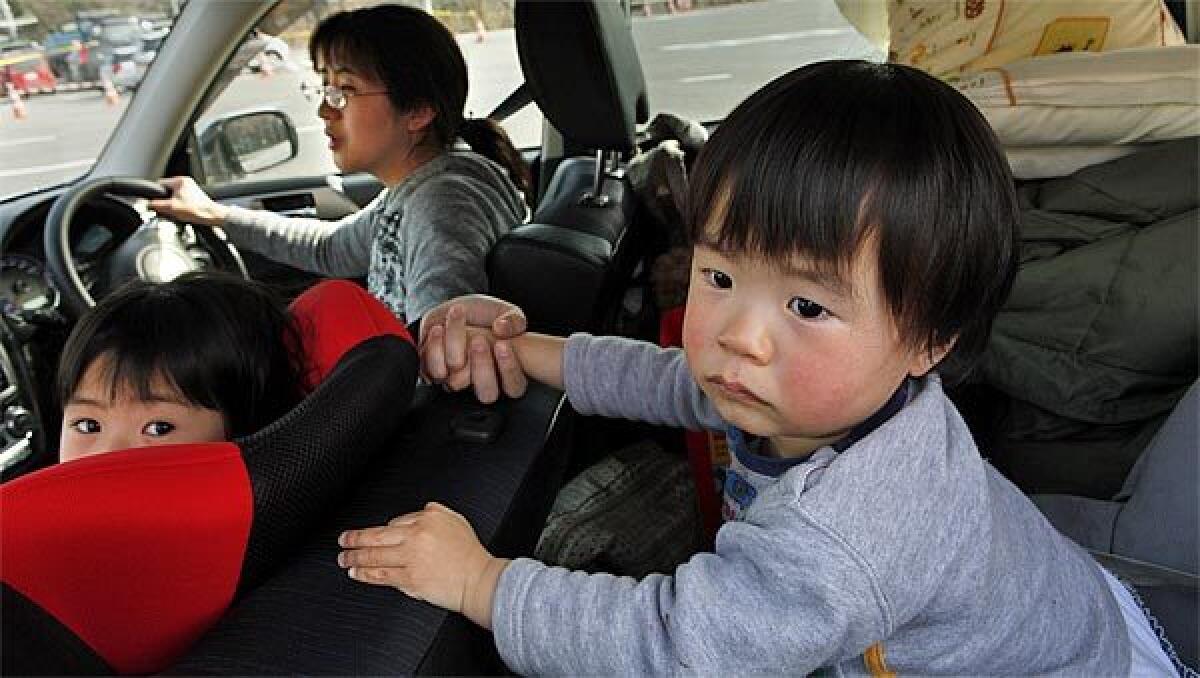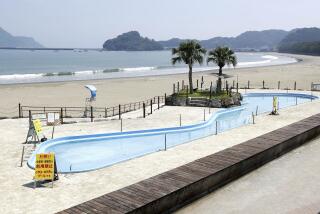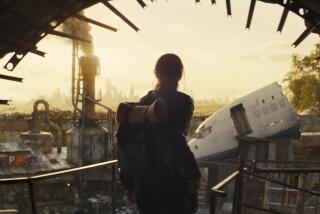Japanese weigh the nuclear risk of staying put

Reporting from Sendai and Minamisanriku, Japan -- — To stay or go. To trust government reassurances or heed more alarmist warnings on the Internet of radioactive clouds wafting over Tokyo. These are among the potentially life-altering questions being pondered by millions of Japanese in range of the crippled nuclear reactors at Fukushima.
Authorities have evacuated more than 170,000 residents within 12 miles of the Fukushima No. 1 (Daiichi) nuclear plant and warned those up to 20 miles away to stay in their homes, with the Japanese government insisting that those farther away are not at great risk.
But with each new report of a fire or explosion at the plant, some people who live beyond the evacuation zone, including some in Tokyo about 150 miles to the south or in Sendai about 50 miles north, have decided to leave.
Photos: Scenes of earthquake destruction
“The first few days I wasn’t that worried about the nuclear situation, but now I’m getting worried. It’s more serious,” said Rotaro Sakai, a 24-year-old engineering student in Sendai, who joined a line at 6 a.m. to snag a coveted bus ticket to Yamagata, to the west.
People seem to be basing their decisions on a combination of technical assessments and emotion, leavened with a healthy dose of skepticism concerning the government.
They pore over weather reports to determine which direction the wind is likely to blow. And they intently study diagrams of fuel rod cooling systems, weighing the staggeringly technical information against the assurances of authorities.
“It is difficult to make an objective decision,” said Masatoshi Onodera, 67, a retiree from Sendai who was squinting at a complicated diagram of a containment vessel on the front page of a newspaper. “As far as what the government is telling us, well, I guess 80 to 90% of it is true.”
Within families, there are debates about what to do. Yumi Matsuya, a Sendai homemaker, said she wasn’t much worried about radiation, but her teenage daughters wanted to leave.
“I’m scared,” said 16-year-old Haruka. “I worry about the effect on my body, about getting cancer later. And I don’t believe the government. I think they’re lying about something.”
The distrust stems from a long history of alleged lies and coverups by Tokyo Electric Power Co., owner of the Fukushima plant. Yukio Edano, Japan’s chief Cabinet secretary, has been holding news conferences several times a day, at each one advising the public to “stay calm,” what might be the national mantra these days.
The government is deciding which information to release, balancing the public’s right to know against prevention of panic, said Richard Tanter, a senior research associate with the Nautilus Institute for Security and Sustainability in Australia.
In downtown Sendai, there were long lines at the bus station. The city is still largely without water, electricity and gasoline, making it difficult for people to leave by car.
Other governments have taken different approaches to the threat. France has advised its citizens in Tokyo to leave if possible. The United States has said that Americans should follow the same procedures Japan has suggested for its own people: in the event of a larger nuclear contagion, wearing masks, staying indoors and covering skin.
Even many normally patient Japanese are expressing deep irritation.
“We’re worried, and the government attitude toward this accident has been very inadequate,” said Hitomi Yamashita, 40, a railway service desk worker in Sendai who grew up in Onagawa, about 15 miles closer to the stricken reactors. “They don’t tell us what we should do, don’t provide good advice.
“At school, there’s very little explanation for our children. This is our children’s health we’re talking about. I’m very, very, very angry and very concerned about getting through the next little while.”
Pakistan’s largest city, Karachi, may seem an unlikely refuge, but if you’re in the shadow of a nuclear reactor in danger of melting down, everything is relative.
“My husband is a bus driver,” said Toshiko Tsuzuki, 55. “We’d like to leave Sendai, go anyplace. We’d love to go back to Karachi where I went as a child. Everyone’s afraid of the nuclear situation.”
Most people in Sendai have yet to form contingency plans, saying their skepticism of the government hasn’t yet reached the level of active distrust. Nonetheless, many are taking small precautions.
Tsuzuki said she bought face masks for her family as the possibility of fallout, and stormy weather, has increased.
“We’re afraid of rain and snow,” she said. “We know from Nagasaki and Hiroshima, it can spread radiation when precipitation falls.”
I’m very worried about the nuclear danger,” said Sayaka Takahashi, an office worker. “That’s why I bought this hat,” a floppy beige fishing hat adorned with cartoon characters. “I hope it will help me cover up.”
She’s also betting that the 50 miles separating Fukushima and Sendai are enough of a safety buffer. Her rough plan in case of disaster is to head toward Hokkaido, Japan’s main northern island, although the gasoline shortage presents a problem.
“I don’t want nuclear plants. I want natural energy or wind,” she said. “On TV, the government says the nuclear plant should be all right, but I don’t trust them. We now put our trust in chain letters.”
These e-mails making the rounds offer advice supposedly from someone who knows someone working at a nuclear plant. Many tell the recipients to wear hats, keep their skin covered, use an umbrella and avoid contact with rain or snow after an accident.
“I don’t know if they’re true or not,” said Asuka Kikuchi, 23. “But many people trust them more than the government.”
The reasons for the confusion are clear. In an NHK radio broadcast Tuesday morning, an announcer said there had been another reactor fire, the fourth in four days.
That was followed a few minutes later by a statement saying there had been no fire after all, followed by another saying there had been.
The conflicting information was then followed by classical piano and violin music, presumably meant to be soothing.
Photos: Scenes of earthquake destruction
Demick reported from Sendai and Magnier from Minamisanriku.
More to Read
Sign up for Essential California
The most important California stories and recommendations in your inbox every morning.
You may occasionally receive promotional content from the Los Angeles Times.










